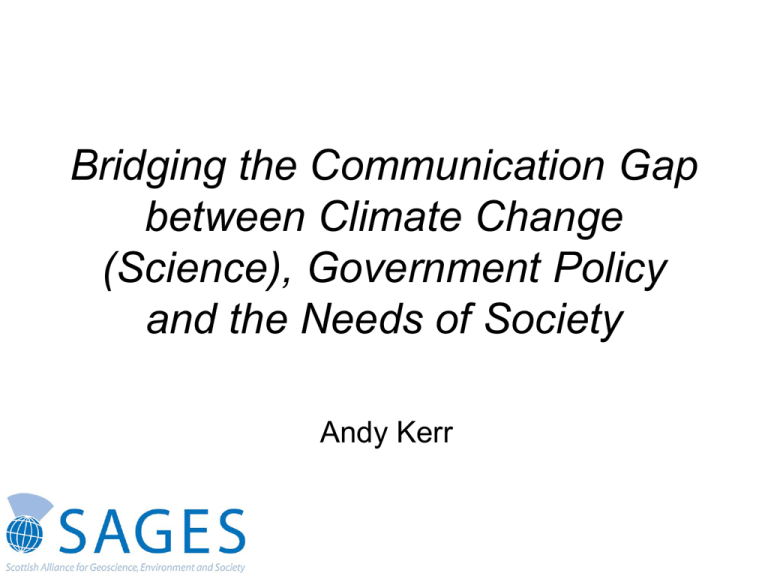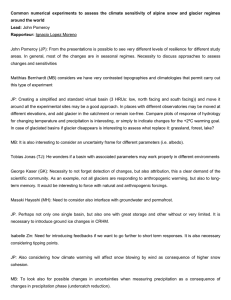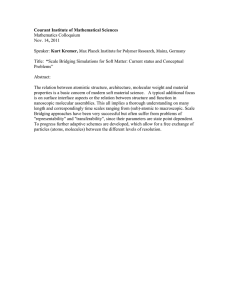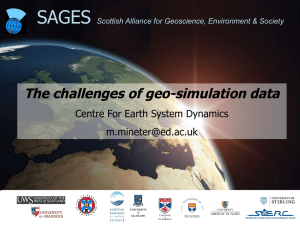Bridging the Communication Gap between Climate Change (Science), Government Policy
advertisement

Bridging the Communication Gap between Climate Change (Science), Government Policy and the Needs of Society Andy Kerr Introduction Introduction Stern Review (2006) “There is still time to avoid the worst impacts of climate change, if we take strong action now.” “Using the results from formal economic models, the Review estimates that if we don’t act, the overall costs and risks of climate change will be equivalent to losing at least 5% of global GDP each year, now and forever. If a wider range of risks and impacts is taken into account, the estimates of damage could rise to 20% of GDP or more. In contrast, the costs of action – reducing greenhouse gas emissions to avoid the worst impacts of climate change – can be limited to around 1% of global GDP each year. The investment that takes place in the next 10-20 years will have a profound effect on the climate in the second half of this century and in the next…” δ – 0.1% per year η–1 In other words, the conclusions were largely driven by their prescribed ethical framework… Sir Partha Dasgupta: The moral is this: we should be very circumspect before accepting numerical values for parameters for which we have little a-priori feel. One can't get an intuitive feel for them from huge computer runs because it is usually not possible to track what's influencing what in a sharp way. Adaptation Societal needs… Optimal decision making requires: – Adequate knowledge – Capacity to plan for the future – Available capital to implement a decision “Adaptation” cannot be imposed solely by government on society, since it involves inherent trade-offs between options, costs and risks by private and public decision makers in different locations and over different timescales Pictures from John Briggs (Glasgow) Diagram from Richard Essery (CESD) Time/space scale issues HadAM3 has: 2.5 latitude 3.75 longitude grid (72 96) 19 levels in the atmosphere 30 minute timestep 2.3 109 space-time points per year! Diagrams from Richard Essery (CESD) Uncertainty issues From IPCC. Future climate possibilities are broad and overlap one another Ensemble of “perturbed physics” models showing large uncertainty range of future warming. Which are right? Diagrams from Prof. Simon Tett (CESD) UKCIP98 – Annual temp “At the UK level generally the warming is greater in winter than in summer. The rate of warming ranges from 0.1°C/decade for the Low scenario to 0.3°C/decade for the High scenario.” UKCIP98 – Summer precip “Annual and winter precipitation increases for all periods and scenarios but they are very modest for the Low and MediumLow scenarios. Winter precipitation increases by 20% for the 2080 High scenario, which is larger than would be expected from natural variability Summer precipitation is lowest in the south of the UK. However the decline only exceeds the range of natural variability in summer in the Southeast for 2080 in MediumHigh and High scenarios. Autumn precipitation changes are similar to those in winter and spring changes are very small.” UKCIP02 “Based on their experience of using UKCIP98, users asked for greater regional and temporal detail, estimates of changes to extremes and better guidance on how to handle uncertainties…” UKCIP089 A probabilistic climate projection aims to allow users to make more robust decisions • IS NOT an objective probability, where a situation is well understood, where all outcomes can be accounted for; • IS rather a subjective probability (similar to horse-racing odds); • encapsulates some, but not all, uncertainty • is dependent on the method used, including assumptions and choices made, meaning that a different method would produce different results; • is based on the current evidence (i.e. models and observations), and new evidence in the future may lead to the results being modified; • does not reduce uncertainty, just makes it more transparent. How can we use this information? Future Now How can we communicate this to decision makers? How will they choose appropriate risk metrics? Diagram from UK Hadley Centre Organisational decision making Risk management strategies Why don’t organisations use UKCIP02? Bridging the Communications Gap 1. Scientists are clearly communicating the strengths/limitations of their studies… 2. Policy/decision makers don’t always know what they want or need… 3. But model outputs are rarely framed in a way amenable to practical decision making. Mitigation Mitigation Societal needs…? Min[ ∫Abatement Costs dt + ∫Environmental Damage dt] From DEFRA, 2008 UK/Scottish Energy System (From UKERC) UK/Scottish Climate Change Bill… 70000.0 60000.0 50000.0 40000.0 30000.0 20000.0 10000.0 0.0 1980 1990 2000 2010 2020 2030 2040 2050 2060 Costs of reducing emissions Net benefit Behaviour matters… • • • • Other people’s behaviour matters Habits are important People are motivated to do the right thing People’s self-expectation influence how they behave • People are loss-adverse • People are bad at computation • People need to feel involved and effective to make a change nef, 2005 People are bad at computation… “…when making decisions: they put undue weight on recent events and too little on far-off ones; they cannot calculate probabilities well and worry too much about unlikely events; and they are strongly influenced by how the problem/information is presented to them.” So what are we doing? Probability distribution functions… Net present values… Bridging the Communications Gap • The gap is not caused by lack of scientific skill • The gap is not from lack of endeavour from scientists trying to better explain their work… • Bridging the gap requires… The End






